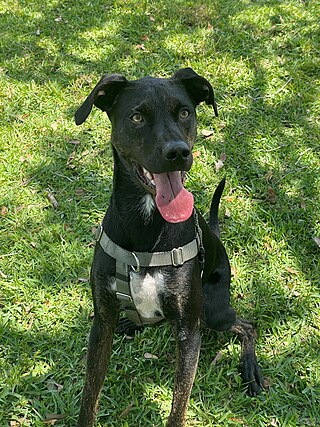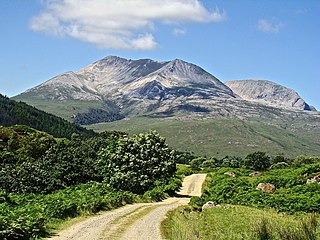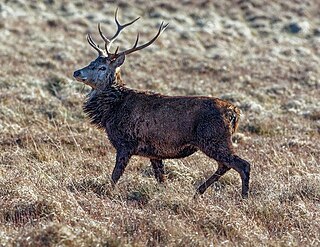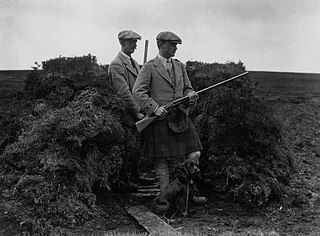
The Labrador Retriever or simply Labrador is a British breed of retriever gun dog. It was developed in the United Kingdom from St. John's water dogs imported from the colony of Newfoundland, and was named after the Labrador region of that colony. It is among the most commonly kept dogs in several countries, particularly in the European world.

The Moray Firth is a roughly triangular inlet of the North Sea, north and east of Inverness, which is in the Highland council area of the north of Scotland.

The Goldendoodle is a designer dog created by crossbreeding a Golden Retriever and a Poodle. First widely bred in the 1990s, they are bred in three different sizes—each corresponding to the size of Poodle used as a parent.

A mongrel, mutt, or mixed-breed dog is a dog that does not belong to one officially recognized breed, including those that result from intentional breeding. Although the term mixed-breed dog is sometimes preferred, many mongrels have no known purebred ancestors.

A police dog, also known as a K-9, is a dog that is trained to assist police and other law enforcement officers. Their duties may include searching for drugs and explosives, locating missing people, finding crime scene evidence, protecting officers and other people, and attacking suspects who flee from officers. The breeds most commonly used by law enforcement are the German Shepherd, Belgian Malinois, Bloodhound, Dutch Shepherd, and Labrador Retriever. In recent years, the Belgian Malinois has become the leading choice for police and military work due to their intense drive, focus, agility, and smaller size, though German Shepherds remain the breed most associated with law enforcement.

Beinn Eighe is a mountain massif in the Torridon area of Wester Ross in the Northwest Highlands of Scotland. Lying south of Loch Maree, it forms a long ridge with many spurs and summits, two of which are classified as Munros: Ruadh-stac Mòr at 1,010 m (3,314 ft) and Spidean Coire nan Clach at 993 m (3,258 ft). Unlike most other hills in the area it has a cap of Cambrian basal quartzite which gives the peaks of Beinn Eighe a distinctive light colour. Its complex topography has made it popular with both hillwalkers and climbers and the national nature reserve on its northern side makes it an accessible mountain for all visitors.

The Nova Scotia Duck Tolling Retriever is a medium-sized gundog bred primarily for hunting. It is often referred to as a "toller". It is the smallest of the retrievers, and is often mistaken for a small Golden Retriever. Tollers are intelligent, eager to please, alert, and energetic. The name "toller" is derived from their ability to lure waterfowl within gunshot range. The breed originated in Yarmouth County, Nova Scotia, Canada. The American Kennel Club ranks the toller as the 87th most popular dog breed.

Dudley Coutts Marjoribanks, 1st Baron Tweedmouth, also known as the Laird of Guisachan and Glenaffric, was a Scottish businessman and a Liberal politician who sat in the House of Commons from 1853 until 1880, when he was elevated to the peerage as Baron Tweedmouth. He was the breeder of the first golden retriever.

Ben Wyvis is a mountain in Easter Ross, in the northern Highlands of Scotland. It lies north-west of Dingwall, in the council area of Highland, and the county of Ross and Cromarty. Ben Wyvis is a large winding and undulating ridge running roughly north–south for about 5 km, the highest point of which is Glas Leathad Mòr at 1,046 metres (3,432 ft). Geologically, the ridge is composed of Moine pelitic gneiss. The mountain is prominent in views of the area, presenting a whale-back shape above the farmland of Strathconon.

Glen Affric is a glen south-west of the village of Cannich in the Highland region of Scotland, some 15 miles west of Loch Ness. The River Affric runs along its length, passing through Loch Affric and Loch Beinn a' Mheadhoin. A minor public road reaches as far as the end of Loch Beinn a' Mheadhoin, but beyond that point only rough tracks and footpaths continue along the glen.

The Tweed Water Spaniel, or Tweed Spaniel, is a breed of dog extinct since the 19th century. It is best known for being involved in the early development of the modern Curly Coated Retriever and Golden Retriever breeds of dogs. They were described as generally brown, athletic dogs from the area around Berwick-upon-Tweed near the River Tweed and close to the Scottish Borders. A type of water dog, the breed was not well known outside the local area. This breed may have been created by crossing local water dogs with imported St. John's water dog, another breed which is also now extinct.

The fauna of Scotland is generally typical of the northwest European part of the Palearctic realm, although several of the country's larger mammals were hunted to extinction in historic times and human activity has also led to various species of wildlife being introduced. Scotland's diverse temperate environments support 62 species of wild mammals, including a population of wild cats, important numbers of grey and harbour seals and the most northerly colony of bottlenose dolphins in the world.

Garbh Eilean is one of the Shiant Islands at the south end of the Minch on the west coast of Scotland.

The Boreray, also known as the Boreray Blackface or Hebridean Blackface, is a breed of sheep originating on the St Kilda archipelago off the west coast of Scotland and surviving as a feral animal on one of the islands, Boreray. The breed was once reared for meat and wool, but is now used mainly for conservation grazing. The Boreray is one of the Northern European short-tailed sheep group of breeds.

The Golden Retriever is a Scottish breed of retriever dog of medium size. It is characterised by a gentle and affectionate nature and a striking golden coat. It is a working dog, and registration is subject to successful completion of a working trial. It is commonly kept as a pet and is among the most frequently registered breeds in several Western countries; some may compete in dog shows or obedience trials, or work as a guide dog.

Driven grouse shooting is a field sport in the United Kingdom involving the shooting of red grouse. It is one of two forms of the sport, the other is walked-up shooting. Driven grouse shooting involves grouse being driven to fly over people with shotguns in fixed positions. In walked-up shooting the participants walk forward in a line and flush the birds as they go. Walked-up shooting is more physically demanding than a driven shoot and typically involves fewer birds being shot.

Nintendogs + Cats is a real-time pet simulation video game for the Nintendo 3DS. It is a sequel to the Nintendogs games for the Nintendo DS systems. It was announced alongside the 3DS during Nintendo's E3 press conference and is a launch game, released February 26, 2011, in Japan, March 25, 2011, in Europe and March 27, 2011, in North America, launched earlier in Australia.

Plodda Falls is a waterfall, situated 5 km south-west of the village of Tomich, near Glen Affric, in the Highlands of Scotland. The falls are 46 m high, and are on the Allt na Bodachan, near where it flows into the Abhainn Deabhag, which in turn joins with the River Affric to form the River Glass.

The Vaynol is one of the United Kingdom's rarest breeds of cattle with less than 150 breeding animals registered. The breed is currently listed as “critical” on the Rare Breed Survival Trust list. There are currently three officially registered herds of Vaynol cattle existing in the United Kingdom. Together with the Chillingham and White Park cattle, the Vaynol is one of three horned breeds derived from ancient white parkland herds from Britain and Ireland. These park cattle were also the basis of a similar fourth breed, the polled British White.



















